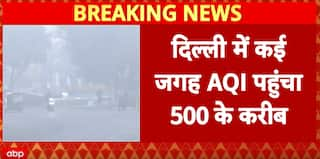NCR's Air Quality In 'Very Poor' Category For Sixth Consecutive Day. Delhi's AQI At 309, Noida At 392
Pollution levels have crept up in Delhi-NCR as there was a drop in temperature and wind speed. Also, due to people bursting firecrackers and a rise in the number of farm fires.

New Delhi: The National Capital Region's air quality remains to be in the 'very poor' category for the sixth consecutive day. Overall Air Quality Index (AQI) in Delhi on Saturday morning is 309 (very poor) while in Noida it is 392.
The System of Air Quality and Weather Forecasting And Research (SAFAR) on Saturday showed AQI in the Delhi University area at 355 and in the Mathura road area at 340.
Air quality dips in Delhi with overall AQI being 309 (very poor) this morning; visuals from Mathura Road, Barakhamba Road & Pragati Maidan
— ANI (@ANI) October 29, 2022
A cart puller, Sukhdev says,"Stepping out of home is a necessity.Breathing gets difficult sometimes,you can feel change in air even in eyes" pic.twitter.com/CAixCoZbfM
On Friday, the 24-hour average AQI stood at 357 at 4 pm, improving from 365 at 4 pm on Thursday. The AQI in Anand Vihar (463) and Ashok Vihar (396) was recorded in the 'severe' category at 6:30 pm, the Central Pollution Control Board (CPCB) data showed.
An AQI between zero and 50 is considered good, 51 and 100 satisfactory, 101 and 200 moderate, 201 and 300 poor, 301 and 400 very poor, and 401 and 500 severe.
"It will be mainly clear the sky on Saturday. The maximum and minimum temperatures are likely to hover around 31 and 15 degrees Celsius respectively," news agency PTI reported an IMD official as saying.
Morning walkers, cyclists & joggers work out near India Gate amid dipping air quality in Delhi
— ANI (@ANI) October 29, 2022
A group of cyclists says, "We're from Gurugram. there's breathing difficulty & irritation in eyes."
Surendra, a fitness enthusiast says, "Govt should see where to go from here next." pic.twitter.com/sECKn9rtJv
Pollution levels crept up on the night of October 23 as there was a drop in temperature and wind speed. Also, due to people bursting firecrackers and a rise in the number of farm fires.
On October 19, the sub-committee of the Commission for Air Quality Management (CAQM) implemented Stage II of the Graded Response Action Plan (GRAP) — a set of anti-air pollution measures followed in Delhi and its vicinity according to the severity of the situation in the capital.
GRAP's Stage II includes banning the use of coal and firewood in hotels, restaurants, and open eateries. The use of diesel generators, except for essential services, is also banned.
GRAP is classified under four stages depending on the air quality in Delhi. Stage I in a case of 'poor' air quality (AQI 201-300), Stage II for 'very poor' air quality, Stage III for 'severe' air quality (AQI 401-450), and Stage IV for 'severe plus' air quality (AQI>450).
If the situation turns 'severe' (Stage III), authorities will enforce a ban on construction and demolition activities in the NCR, except for essential projects (such as railways, metros, airports, ISBTs, and national security/defence-related projects of national importance).
(With Agency Inputs)






































